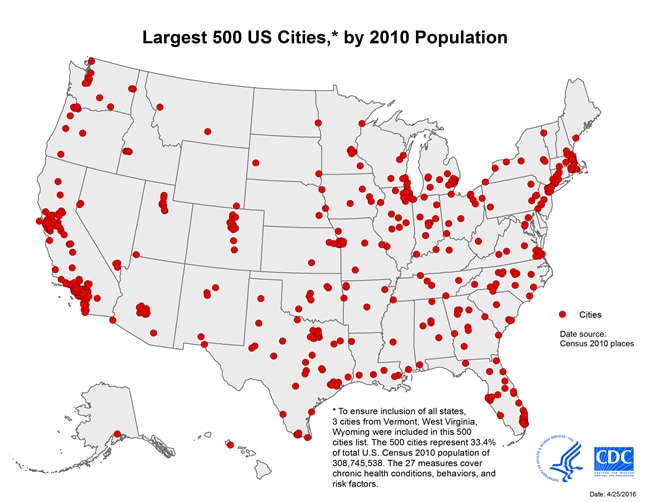500 Cities Project: 2016 to 2019

The 500 Cities Project was replaced by the PLACES Project on December 2020. It was a collaboration between CDC, the Robert Wood Johnson Foundation, and the CDC Foundation. It provided city- and census tract-level small area estimates for chronic disease risk factors, health outcomes, and clinical preventive services use for the largest 500 cities in the United States. These small area estimates allowed cities and local health departments to better understand the burden and geographic distribution of health-related variables in their jurisdictions and assisted them in planning public health interventions.
- This project reported city- and census tract-level data and used small area estimation methods to obtain 27 chronic disease measures for the 500 largest American cities.
- The data were published through a public, interactive “500 Cities” website that allowed users to view, explore, and download city- and tract-level data.
- Although limited data were available at the county and metropolitan levels, this project represented a first-of-its-kind data analysis to release information on a large scale for cities and for small areas within cities. This system complemented existing surveillance data necessary to more fully understand the health issues affecting the residents of that city or census tract.
- These high-quality, small-area epidemiologic data could have been used both by individual cities and groups of cities as well as other stakeholders to help develop and implement effective and targeted prevention activities; identify emerging health problems; and establish and monitor key health objectives. For example, city planners and elected officials may have wanted to use this data to target neighborhoods with high rates of smoking or other health risk behaviors for effective interventions.
- The project delivered data for the 497 largest American cities and included data from the largest cities in Vermont (Burlington—population: 42,417), West Virginia (Charleston—population: 51,400) and Wyoming (Cheyenne—population: 59,466) to ensure inclusion of cities from all the states; that brought the total to 500 cities.
- The number of cities per state ranged from 1 to 121.
- The cities ranged in population from 42,417 in Burlington, Vermont, to 8,175,133 in New York City, New York.
- Among these 500 cities, there were approximately 28,000 census tracts, for which data was provided. The tracts ranged in population from less than 50 to 28,960, and in size from less than 1 square mile to more than 642 square miles. The number of tracts per city ranged from 8 to 2,140.
- The project included a total population of 103,020,808, which represented 33.4% of the total United States population of 308,745,538.

- The 500 Cities Project reflected innovations in generating valid small area estimates for population health.
- It provided data for cities, many of which covered multiple counties or did not follow county boundaries, and census tracts for the first time. These data were filterable (by city and/or tracts; as well as by measure) and downloadable for use in separate analyses by the end-users.
- The project enabled retrieval, visualization, and exploration of uniformly defined selected city- and tract-level data for the largest 500 US cities for conditions, behaviors, and risk factors that have a substantial effect on population health.